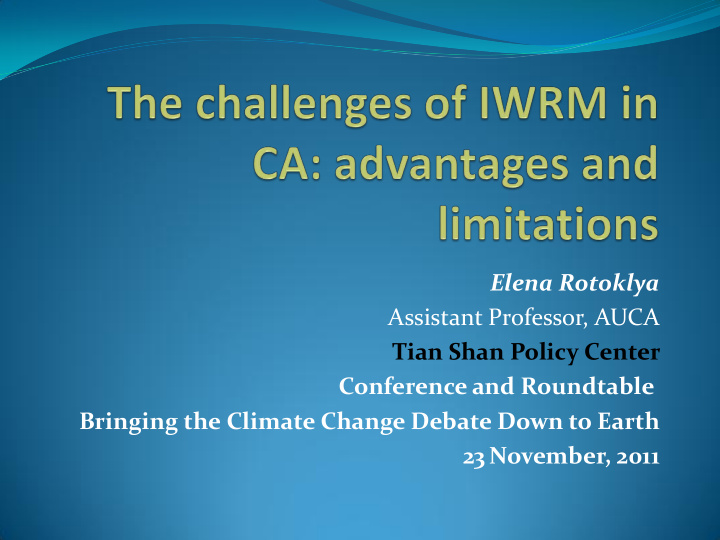



Elena Rotoklya Assistant Professor, AUCA Tian Shan Policy Center Conference and Roundtable Bringing the Climate Change Debate Down to Earth 23 November, 2011
Water Governance in Central Asia Europe Aid/125803/C/SER/MULTI Introduction: Project Components Water Quality Capacity (WQ) Regional building management cooperation Economic Legal & River Basin Instruments institutional (RB) Planning (EI’s ) Duration: EU WG IWRM Project CA 2008-2011 Participating countries : Kyrgyzstan, Tajikistan, Kazakhstan & Turkmenistan
IWRM Definition Integrated Water Resources Management (IWRM) - “ process, which promotes co-coordinated development and management of water, land and related resources, in order to maximize the resultant economic and social welfare in an equitable manner without compromising the sustainability of vital eco- systems” (Global Water Partnership) What IWRM is not? Transfer of irrigation operation to WUAs Water agreements with neighbouring countries
IWRM Principles Water & land resources managed together Social, economic & RB-administrative environmental factors are management unit integrated Transparency & Surface & ground water accountability in WM are managed together decision-making and planning Public participation is necessary for decision-making
IWRM Advantages 1. Achieving 3. Economic 2. Better water consensus efficiency quality * Application of EI’s *Imbalanced water *IWM institutions use=>& water PPP balances, RBM *Better WQ monitoring
IWRM: Limitations in CA 2. Water – 1. “Idealized” production tool 3. Economic IWRM efficiency *Inert structures * Long-term goal *Advanced EI’s? *Old WQ Standards *Differences *Gradual reforms system
Conclusion 1. Change of management approach 2. Functional WRM system 3. Efficient WQ monitoring scheme 4. Recovering operation & maintenance costs 5. Common vision & planning IWRM in CA
Recommend
More recommend